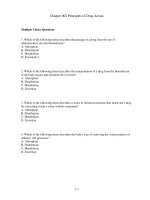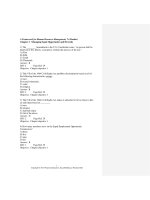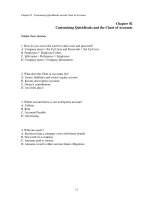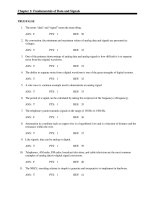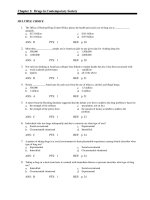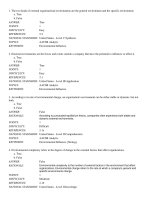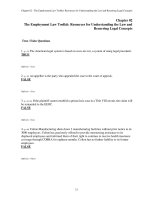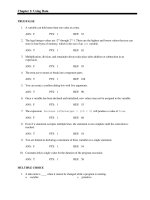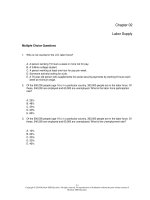Administering medications 7th edition donna gauwitz test bank
Bạn đang xem bản rút gọn của tài liệu. Xem và tải ngay bản đầy đủ của tài liệu tại đây (143.71 KB, 64 trang )
Chapter 002 Principles of Drug Action
Multiple Choice Questions
1. Which of the following terms describes the passage of a drug from the site of
administration into the bloodstream?
A. Absorption
B. Distribution
C. Metabolism
D. Excretion11.
2. Which of the following terms describes the transportation of a drug from the bloodstream
to the body tissues and intended site of action?
A. Absorption
B. Distribution
C. Metabolism
D. Excretion
3. Which of the following terms describes a series of chemical reactions that inactivate a drug
by converting it into a water-soluble compound?
A. Absorption
B. Distribution
C. Metabolism
D. Excretion
4. Which of the following terms describes the body's way of removing the waste products of
ordinary cell processes?
A. Absorption
B. Distribution
C. Metabolism
D. Excretion
2-1
Chapter 002 Principles of Drug Action
5. Which of the following statements describes the action that antihistamines have on the
body?
A. Slow the body's natural reactions to irritation
B. Speed up the energy-producing functions of cells
C. Destroy parts of cells
D. Replace natural substances that the body lacks
6. Which of the following statements describes the action that stimulants have on the body?
A. Slow the body's natural reactions to irritation
B. Speed up the energy-producing functions of cells
C. Destroy parts of cells
D. Replace natural substances that the body lacks
7. Which of the following statements describe the action that insulin has on the body?
A. Slow the body's natural reactions to irritation
B. Speed up the energy-producing functions of cells
C. Destroy parts of cells
D. Replace natural substances that the body lacks
8. Which of the following statements describes the action that antibiotics have on the body?
A. Slow the body's natural reactions to irritation
B. Speed up the energy-producing functions of cells
C. Destroy parts of cells
D. Replace natural substances that the body lacks
9. Age, size, sex, and genetics are all factors that:
A. affect drug excretion.
B. affect drug metabolism.
C. affect drug action.
D. affect drug distribution.
2-2
Chapter 002 Principles of Drug Action
10. The route of administration, and the time of day that the drug is administered, diet, and
environmental conditions are all factors that:
A. Affect drug excretion.
B. Affect drug metabolism.
C. Affect drug action.
D. Affect drug distribution.
11. Which of the following statements describes how a health care worker can create a
positive attitude in patients who are undergoing medication therapy?
A. Review, with the patient, the important reasons for taking the medication.
B. Treat the patient in a cheerful and caring manner.
C. Maintain your own positive, confident attitude.
D. All answers are correct.
12. Which of the following describes the effect of a drug that is mainly limited to the area
where it is applied or enters the body?
A. Side effect
B. Local effect
C. Systemic effect
D. Therapeutic effect
13. Which of the following describes the effect of a drug that must travel through the
bloodstream to affect cells or tissues in various parts of the body?
A. Side effect
B. Local effect
C. Systemic effect
D. Therapeutic effect
2-3
Chapter 002 Principles of Drug Action
14. Which of the following describes the desired effect of a drug, or the reason the drug is
administered?
A. Side effect
B. Local effect
C. Systemic effect
D. Therapeutic effect
15. Which of the following describes additional effects on the body that are not a part of the
goal of drug therapy?
A. Side effects
B. Local effects
C. Systemic effects
D. Therapeutic effects
16. Which of the following terms describes the interaction of two drugs to inhibit or cancel
each other's effect?
A. Synergism
B. Potentiation
C. Antagonism
D. Idiosyncrasy
17. Which of the following terms describes a drug interaction in which the effect of two drugs
in combination is greater than the effect of each drug given separately?
A. Synergism
B. Potentiation
C. Antagonism
D. Idiosyncrasy
2-4
Chapter 002 Principles of Drug Action
18. Which of the following terms describes the drug interaction that occurs when two drugs
are administered at the same time, and one drug increases the effect of the other?
A. Synergism
B. Potentiation
C. Antagonism
D. Idiosyncrasy
19. Psychological drug dependence is:
A. a drive or craving to take a drug to relieve discomfort.
B. a physical need for the drug.
C. the self-administration of a drug in chronically excessive quantities.
D. a problem with people who take their own medications at home.
20. Physical drug dependence is:
A. a drive or craving to take a drug to relieve discomfort.
B. a physical need for the drug.
C. the self-administration of a drug in chronically excessive quantities.
D. a problem with people who take their own medications at home.
21. Withdrawal symptoms can occur as a result of:
A. physical drug dependence.
B. psychological drug dependence.
C. drug misuse.
D. drug side effects.
22. Which of the following are examples of drugs that are commonly abused?
A. Caffeine, nicotine, alcohol
B. Barbiturates, depressants, stimulants
C. Anabolic steroids, sedatives, hypnotics
D. All answers are correct.
2-5
Chapter 002 Principles of Drug Action
23. Which of the following statements describes the health care worker's responsibilities with
respect to the administration of drugs?
A. The health care worker is expected to be aware of possible adverse drug reactions, drug
dependence, and the improper use of drugs.
B. The health care worker must consult his supervisor when drug abuse is suspected.
C. The health care worker must keep medicines locked up when not in use.
D. All answers are correct.
24. Which of the following is NOT one of the four processes that affect drug action?
A. Absorption
B. Biotransformation
C. Distribution
D. Potentiation
25. Which of the following describes why pain medications are prescribed?
A. For the local effect they provide
B. For the systemic effect they provide
C. For the side effects they provide
D. For the cumulative effects they provide
26. The ability of a drug to cross the cell membrane and the rate at which it can do so affects
which of the following?
A. Pharmacokinetics
B. Tolerance
C. Side effects
D. Therapeutic effect
27. Which of the following is NOT a way that a drug interacts with the normal processes
carried on by body cells?
A. The size and shape of drug molecules
B. The ability of drugs to dissolve in water or fat
C. The pH balance of drugs and cells
D. The route of administration
2-6
Chapter 002 Principles of Drug Action
28. How quickly and completely a drug is absorbed into the bloodstream affects which of the
following?
A. Drug action
B. Drug tolerance
C. Drug toxicity
D. Drug dependence
29. Which of the following routes of administration provides the fastest and most dependable
absorption of a drug?
A. Oral
B. Intramuscular
C. Buccal
D. Intravenous
30. Which of the following is an example of a drug that is administered through the sublingual
route?
A. Ibuprofen
B. Nitroglycerin
C. Epinephrine
D. Meperidine
31. Bactrim is considered a long-lasting antibiotic for which of the following reasons?
A. Bactrim collects in drug reservoirs
B. Bactrim is absorbed very slowly
C. Bactrim is prescribed for 7 to 10 days
D. Bactrim resists biotransformation
32. Enzymes that break down a drug are involved in which of the following processes?
A. Absorption
B. Distribution
C. Metabolism
D. Excretion
2-7
Chapter 002 Principles of Drug Action
33. In which of the following organs does most of the metabolism and detoxification of drugs
takes place?
A. Kidneys
B. Stomach
C. Liver
D. Colon
34. The chemical composition of a drug, the rate of metabolism, and how often a drug is
administered all effect which of the following?
A. Absorption
B. Distribution
C. Detoxification
D. Excretion
35. An increased risk of toxicity from exposures to high doses of a drug is not associated with
which of the following patient types?
A. Older adult
B. Pediatric
C. Kidney disease
D. Pregnant
36. Which of the following are used to calculate proper adult dose?
A. Age and body weight
B. Body mass index and percent of body fat
C. Lean body mass and height
D. Body surface area and muscle mass
37. Which of the following decreases the effects of Coumadin on blood clotting?
A. Milk products
B. Green leafy vegetables
C. Mineral oil
D. Antacids
2-8
Chapter 002 Principles of Drug Action
38. Which of the following is an inactive substance that has no pharmacological effect but can
make a patient feel better?
A. Placebo
B. Palliative drug
C. Legend drug
D. Supplement
39. Which of the following will cause drugs that are taken orally to be absorbed more
quickly?
A. Gastrointestinal tract free of food
B. Increased fluid intake
C. Exercise
D. Good oral hygiene
40. Which of the following can occur with older adults who see multiple doctors and are
prescribed multiple drugs?
A. Drug toxicity
B. Cumulative effect
C. Drug interactions
D. Drug tolerance
41. Which of the following is a side effect of aspirin therapy?
A. Stomach irritation
B. Constipation
C. Rash
D. Urine retention
42. When observing a patient's reaction to a drug that has been administered, determine
whether you are seeing the drug's therapeutic effect or a
A. Side effect
B. Systemic effect
C. Drug effect
D. Local effect
2-9
Chapter 002 Principles of Drug Action
43. Edema of the pharynx and larynx, severe wheezing, and dyspnea are symptoms of which
of the following?
A. Drug overdose
B. Anaphylaxis
C. Enzyme deficiency
D. Drug toxicity
44. When a patient presents with an idiosyncratic response to a drug, which of the following
is the recommended treatment?
A. Change medication
B. If therapeutic, continue medication
C. Stop medication
45. Drugs such as opiates, nitrates, and barbiturates frequently produce which of the
following?
A. Toxicity
B. Potentiation
C. Tolerance
D. Synergism
46. Which of the following can be used to reverse overdose symptoms?
A. Placebo
B. Antidote
C. Histamine
D. Epi Pen
47. Patients who take sedatives are advised to avoid drinking alcohol to avoid the possibility
of which of the following?
A. Antagonism
B. Synergism
C. Potentiation
D. Toxicity
2-10
Chapter 002 Principles of Drug Action
48. The process whereby antacids and iron supplements work against the absorption of the
antibiotic tetracycline is described by which of the following terms?
A. Antagonism
B. Synergism
C. Potentiation
D. Idiosyncrasy
49. Which of the following terms refers to the self-administration of a drug in chronically
excessive quantities, resulting in a psychological or physical dependence?
A. Drug abuse
B. Drug overuse
C. Drug self-use
D. Drug tolerance
Essay Questions
50. State the four basic drug actions.
51. Name the four body processes that affect drug action.
2-11
Chapter 002 Principles of Drug Action
52. Identify 10 factors influencing drug actions.
53. Differentiate between systemic and local drug effects.
54. State the difference between the therapeutic effect and side effects.
55. Define synergism.
2-12
Chapter 002 Principles of Drug Action
56. Define antagonism.
57. Define potentiation.
58. Explain the difference between psychological and physical drug dependence.
59. List five commonly abused drugs.
2-13
Chapter 002 Principles of Drug Action
60. State the health care worker's responsibilities with regard to adverse reactions of drugs,
dependence, and drug abuse.
Fill in the Blank Questions
61. Insulin is an example of a drug that is taken to ___________________a substance that the
body lacks.
________________________________________
62. Antibiotics are examples of drugs that _______________cells or parts of cells.
________________________________________
63. The energy-producing functions of cells are sped up by ____________________.
________________________________________
64. The body's natural reaction to irritation is ____________________by antihistamines.
________________________________________
65. The passage of a drug from the site of administration into the bloodstream is
called________________.
________________________________________
2-14
Chapter 002 Principles of Drug Action
66. The transportation of a drug from the bloodstream to the body tissues and intended site of
action is called _________________.
________________________________________
67. The series of chemical reactions that inactivate a drug by converting it into a watersoluble compound so that it can be excreted by the body is termed___________________.
________________________________________
68. The body's way of removing the waste products of ordinary cell processes is
termed__________________
________________________________________
69. Smaller doses and different drugs are required in treating the young or the older adult.
This is an example of how _____________is a factor that affects drug action.
________________________________________
70. To diminish the unpleasant effects of drugs secreted through saliva, the patient should be
educated to chew ______________or suck hard candy.
________________________________________
71. Combining certain drugs with certain foods can alter the drug's effects. This is an example
of the effect that a person's ___________has on drug action.
________________________________________
72. Because some drugs may harm the fetus, ______________________women must be
extremely careful about taking any medication, and must avoid taking medications without
first consulting their physician.
________________________________________
2-15
Chapter 002 Principles of Drug Action
73. Each person's individual makeup causes slight differences in basic processes like
metabolism and excretion. This is an example of the effect that ______________has on drug
action.
________________________________________
74. Diseases of the liver and kidneys can have an important effect on the processing and
elimination of drugs. This is an example of how _________________________affect drug
action.
________________________________________
75. A patient's mental state is an important factor in the success or failure of drug therapy.
This is an example of the effect __________________________________have on drug
action.
________________________________________
76. A ______________________is an inactive substance that has no pharmacological effects
but may make a patient with a positive attitude "feel better."
________________________________________
77. As a member of the health care team, you can influence a patient's response to medication
by creating a _______________________attitude in the patient.
________________________________________
78. Drugs are absorbed, distributed, and metabolized differently when given by different
_________________.
________________________________________
79. A drug will act most quickly when it is __________________into the bloodstream.
________________________________________
2-16
Chapter 002 Principles of Drug Action
80. The route of administration resulting in the longest time for drugs to show their effects is
the _______________route.
________________________________________
81. When possible, drugs that make a patient sleepy are ordered to be taken at bedtime.
This is an example of the effect ________________has on drug action.
________________________________________
82. Drugs that are taken orally are absorbed most quickly if the gastrointestinal tract is free of
_______________.
________________________________________
83. When drugs collect in the body and produce an increased response, it is termed a
______________________effect of drug action.
________________________________________
84. When a patient is less responsive to a drug after repeated doses, it is termed
drug__________________.
________________________________________
85. If a patient has a drug _________________, it must be clearly marked on the front of the
chart with a bright sticker.
________________________________________
86. Older adult patients often see several doctors who prescribe what is needed in a patient's
particular case. Multiple doctors and multiple drugs can lead to serious drug
____________________.
________________________________________
2-17
Chapter 002 Principles of Drug Action
87. Heat relaxes the blood vessels and speeds up the circulation, so drugs act faster. This is an
example of the effect that _______________________conditions have on drug action.
________________________________________
88. The term drug __________________refers to the chemical changes the drug produces in
cells and tissues.
________________________________________
89. The combination of biological, physical, and psychological changes that takes place in the
body as a result of the drug action is termed the drug _________________.
________________________________________
90. The desired effect, or the reason a drug is administered, is termed the
_____________________effect.
________________________________________
91. Additional effects that drugs have on the body that are not part of the goal of drug therapy
are termed_______________________ effects.
________________________________________
92. Aspirin, taken orally, is beneficial for the treatment of arthritis, but tends to irritate the
lining of the stomach. This side effect is controlled by giving the drug with milk or
____________.
________________________________________
93. Some drugs mainly affect the area they enter, or are applied to, the body, for example, eye
drops and sunburn creams. This is an example of the ________________effects of drugs.
________________________________________
2-18
Chapter 002 Principles of Drug Action
94. Pain medications that must travel through the bloodstream to affect cells or tissues in
other parts of the body are an example drugs given for their _____________________effects.
________________________________________
95. Occasionally, the body has an unexpected or dangerous response to a drug. These
unexpected conditions are called ___________________reactions.
________________________________________
96. A drug ______________is an abnormal response that occurs because a person has
developed antibodies against a particular drug.
________________________________________
97. ___________________is a substance released by injured cells that is responsible for the
symptoms usually seen in allergic reactions.
________________________________________
98. A substance, for example, a drug, that stimulates the production of antibodies and causes
allergic reaction is termed an _________________.
________________________________________
99. An ______________________is a substance produced in the body that helps the body
fight off foreign invaders like microorganisms and antigens.
________________________________________
100. An extreme, possibly life-threatening, hypersensitivity reaction to a previously
encountered antigen is termed _____________________.
________________________________________
2-19
Chapter 002 Principles of Drug Action
101. ______________________are abnormal or peculiar responses that people may have to
certain drugs.
________________________________________
102. Drug ___________________ is the need for an increasingly larger dose of a drug in
order to produce the same physiological and/or psychological effects.
________________________________________
103. When the body cannot metabolize and excrete one dose of a drug completely before the
next dose is given a ________________________effect occurs.
________________________________________
104. An __________________is a dose of a medication that is too large for a patient's age,
size, and/or physical condition.
________________________________________
105. ___________________refers to the drug's ability to poison the body.
________________________________________
106. An ______________________is a drug that has an opposite effect and can reverse the
overdose symptoms.
________________________________________
107. When one drug modifies the action of another drug, it is termed a drug
________________________.
________________________________________
2-20
Chapter 002 Principles of Drug Action
108. When two drugs administered together produce a more powerful response than the effect
of each drug given separately, it is called ___________________.
________________________________________
109. ____________________occurs when two drugs are administered at the same time, and
one drug increases the effect of the other drug.
________________________________________
110. A drug interaction in which two drugs inhibit or cancel each other's effect is called
____________________.
________________________________________
111. Drug ______________________is a strong psychological and/or physical need to take a
certain drug.
________________________________________
112. When a person has a drive or a craving to take a certain drug for pleasure or to relieve
discomfort, they are experiencing ______________________drug dependence.
________________________________________
113. In _____________________drug dependence, the body grows so accustomed to the drug
that it needs it to function.
________________________________________
114. ___________________symptoms are a set of physical reactions that occur when a
person stops taking a drug on which they are physically dependent.
________________________________________
2-21
Chapter 002 Principles of Drug Action
115. Drug ____________________refers to self-administration of a drug in chronically
excessive quantities, resulting in a psychological or physical dependence.
________________________________________
116. The overuse or careless use of any drug is termed drug ___________________.
________________________________________
2-22
Chapter 002 Principles of Drug Action Key
Multiple Choice Questions
1. (p. 24) Which of the following terms describes the passage of a drug from the site of
administration into the bloodstream?
A. Absorption
B. Distribution
C. Metabolism
D. Excretion11.
The passage of a drug from the site of administration into the bloodstream is called
absorption.
Bloom's: Remember
Difficulty: Easy
Learning Outcome: 2-2
2. (p. 24) Which of the following terms describes the transportation of a drug from the
bloodstream to the body tissues and intended site of action?
A. Absorption
B. Distribution
C. Metabolism
D. Excretion
After a drug is absorbed, the transportation of that drug from the bloodstream to the body
tissues and intended site of action is called distribution.
Bloom's: Remember
Difficulty: Easy
Learning Outcome: 2-2
2-23
Chapter 002 Principles of Drug Action Key
3. (p. 26) Which of the following terms describes a series of chemical reactions that inactivate a
drug by converting it into a water-soluble compound?
A. Absorption
B. Distribution
C. Metabolism
D. Excretion
Metabolism is a series of chemical reactions that inactivate a drug by converting it into a
water-soluble compound.
Bloom's: Remember
Difficulty: Easy
Learning Outcome: 2-2
4. (p. 26) Which of the following terms describes the body's way of removing the waste
products of ordinary cell processes?
A. Absorption
B. Distribution
C. Metabolism
D. Excretion
Excretion is the body's way of removing the waste products of ordinary cell processes.
Bloom's: Remember
Difficulty: Easy
Learning Outcome: 2-2
5. (p. 24) Which of the following statements describes the action that antihistamines have on the
body?
A. Slow the body's natural reactions to irritation
B. Speed up the energy-producing functions of cells
C. Destroy parts of cells
D. Replace natural substances that the body lacks
Antihistamines slow the body's natural reactions to irritation.
Bloom's: Remember
Difficulty: Easy
Learning Outcome: 2-3
2-24
Chapter 002 Principles of Drug Action Key
6. (p. 24) Which of the following statements describes the action that stimulants have on the
body?
A. Slow the body's natural reactions to irritation
B. Speed up the energy-producing functions of cells
C. Destroy parts of cells
D. Replace natural substances that the body lacks
Stimulants speed up the energy-producing functions of cells.
Bloom's: Remember
Difficulty: Easy
Learning Outcome: 2-3
7. (p. 24) Which of the following statements describe the action that insulin has on the body?
A. Slow the body's natural reactions to irritation
B. Speed up the energy-producing functions of cells
C. Destroy parts of cells
D. Replace natural substances that the body lacks
Insulin is taken because the pancreas is unable to produce insulin to maintain normal blood
glucose levels.
Bloom's: Understand
Difficulty: Intermediate
Learning Outcome: 2-3
8. (p. 24) Which of the following statements describes the action that antibiotics have on the
body?
A. Slow the body's natural reactions to irritation
B. Speed up the energy-producing functions of cells
C. Destroy parts of cells
D. Replace natural substances that the body lacks
Antibiotics kill disease microorganisms.
Bloom's: Remember
Difficulty: Easy
Learning Outcome: 2-3
2-25
